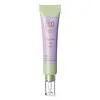What's inside
What's inside
 Key Ingredients
Key Ingredients

 Benefits
Benefits

 Concerns
Concerns

 Ingredients Side-by-side
Ingredients Side-by-side

Ethylhexyl Palmitate
EmollientDiisostearyl Malate
EmollientTridecyl Trimellitate
EmollientPolybutene
Hydrogenated Styrene/Isoprene Copolymer
Phenoxyethanol
PreservativeTocopheryl Acetate
AntioxidantSimmondsia Chinensis Seed Oil
EmollientButyrospermum Parkii Butter
Skin ConditioningMangifera Indica Seed Butter
Skin ConditioningCarthamus Tinctorius Seed Oil
MaskingCamellia Sinensis Leaf Extract
AntimicrobialSilica Dimethyl Silylate
EmollientCananga Odorata Flower Oil
MaskingRetinyl Palmitate
Skin ConditioningPentaerythrityl Tetra-Di-T-Butyl Hydroxyhydrocinnamate
AntioxidantButylene Glycol
HumectantCaprylyl Glycol
EmollientSodium Hyaluronate
HumectantHexylene Glycol
EmulsifyingTocopherol
AntioxidantAroma
Linalool
PerfumingLimonene
PerfumingEthylhexyl Palmitate, Diisostearyl Malate, Tridecyl Trimellitate, Polybutene, Hydrogenated Styrene/Isoprene Copolymer, Phenoxyethanol, Tocopheryl Acetate, Simmondsia Chinensis Seed Oil, Butyrospermum Parkii Butter, Mangifera Indica Seed Butter, Carthamus Tinctorius Seed Oil, Camellia Sinensis Leaf Extract, Silica Dimethyl Silylate, Cananga Odorata Flower Oil, Retinyl Palmitate, Pentaerythrityl Tetra-Di-T-Butyl Hydroxyhydrocinnamate, Butylene Glycol, Caprylyl Glycol, Sodium Hyaluronate, Hexylene Glycol, Tocopherol, Aroma, Linalool, Limonene
Water
Skin ConditioningPersea Gratissima Oil
Skin ConditioningGlycerin
HumectantCetearyl Alcohol
EmollientPotassium Cetyl Phosphate
EmulsifyingButyrospermum Parkii Butter
Skin ConditioningSimmondsia Chinensis Seed Oil
EmollientSqualane
EmollientHydroxyethyl Acrylate/Sodium Acryloyldimethyl Taurate Copolymer
Emulsion StabilisingPanthenol
Skin ConditioningRetinol
Skin ConditioningSambucus Nigra Flower Extract
RefreshingVaccinium Angustifolium Fruit Extract
Skin ProtectingHelianthus Annuus Seed Oil
EmollientGlycyrrhiza Glabra Root Extract
BleachingHydrolyzed Collagen
EmollientTocopherol
AntioxidantAdenosine
Skin ConditioningSodium Hyaluronate
HumectantC12-15 Alkyl Benzoate
AntimicrobialSorbitan Laurate
EmulsifyingC18-36 Acid Glycol Ester
EmollientC18-36 Acid Triglyceride
EmollientPalmitoyl Tripeptide-1
Skin ConditioningPalmitoyl Tetrapeptide-7
Skin ConditioningCaffeine
Skin ConditioningXanthan Gum
EmulsifyingDisodium EDTA
Polysorbate 60
EmulsifyingPhenoxyethanol
PreservativeEthylhexylglycerin
Skin ConditioningLaureth-23
CleansingBHT
AntioxidantBHA
AntioxidantWater, Persea Gratissima Oil, Glycerin, Cetearyl Alcohol, Potassium Cetyl Phosphate, Butyrospermum Parkii Butter, Simmondsia Chinensis Seed Oil, Squalane, Hydroxyethyl Acrylate/Sodium Acryloyldimethyl Taurate Copolymer, Panthenol, Retinol, Sambucus Nigra Flower Extract, Vaccinium Angustifolium Fruit Extract, Helianthus Annuus Seed Oil, Glycyrrhiza Glabra Root Extract, Hydrolyzed Collagen, Tocopherol, Adenosine, Sodium Hyaluronate, C12-15 Alkyl Benzoate, Sorbitan Laurate, C18-36 Acid Glycol Ester, C18-36 Acid Triglyceride, Palmitoyl Tripeptide-1, Palmitoyl Tetrapeptide-7, Caffeine, Xanthan Gum, Disodium EDTA, Polysorbate 60, Phenoxyethanol, Ethylhexylglycerin, Laureth-23, BHT, BHA
Ingredients Explained
These ingredients are found in both products.
Ingredients higher up in an ingredient list are typically present in a larger amount.
This ingredient is also known as shea butter. It is an effective skin hydrator and emollient.
Emollients help soothe and soften your skin. It does this by creating a protective film on your skin. This barrier helps trap moisture and keeps your skin hydrated. Emollients may be effective at treating dry or itchy skin.
Shea butter is rich in antioxidants. Antioxidants help fight free-radicals, or molecules that may harm the body. It is also full of fatty acids including stearic acid and linoleic acid. These acids help replenish the skin and keep skin moisturized.
While Shea Butter has an SPF rating of about 3-4, it is not a sunscreen replacement.
Shea butter may not be fungal acne safe. We recommend speaking with a professional if you have any concerns.
Learn more about Butyrospermum Parkii ButterPhenoxyethanol is a preservative that has germicide, antimicrobial, and aromatic properties. Studies show that phenoxyethanol can prevent microbial growth. By itself, it has a scent that is similar to that of a rose.
It's often used in formulations along with Caprylyl Glycol to preserve the shelf life of products.
This oil comes from the seeds of the desert shrub called Jojoba. It is more commonly known as jojoba oil, a non-comedogenic oil.
Jojoba oil does not contain fragrance and has many fatty-acids, making it a great soothing ingredient.
It also contains Vitamin E, a great moisturizing ingredient. Vitamin E is also an antioxidant and protects your skin against oxidative damage.
This ingredient humectant properties, meaning it helps draw moisture from the air. This helps keep your skin hydrated.
While jojoba has antibacterial properties, it is only able to kill some strains of bacteria.
Studies also show it helps in wound healing. In fact, Indigenous cultures have used jojoba as a moisturizer and to help treat burns for centuries.
Fun fact: Jojoba oil similar to natural human skin sebum, so it has a great effect on dry skin. It is also promising with helping to regulate sebum production.
Due to its fatty acid content, Jojoba oil may not be fungal acne safe. We recommend speaking with a professional if you have any concerns.
Learn more about Simmondsia Chinensis Seed OilSodium Hyaluronate is hyaluronic acid's salt form. It is commonly derived from the sodium salt of hyaluronic acid.
Like hyaluronic acid, it is great at holding water and acts as a humectant. This makes it a great skin hydrating ingredient.
Sodium Hyaluronate is naturally occurring in our bodies and is mostly found in eye fluid and joints.
These are some other common types of Hyaluronic Acid:
Learn more about Sodium HyaluronateTocopherol (also known as Vitamin E) is a common antioxidant used to help protect the skin from free-radicals and strengthen the skin barrier. It's also fat soluble - this means our skin is great at absorbing it.
Vitamin E also helps keep your natural skin lipids healthy. Your lipid skin barrier naturally consists of lipids, ceramides, and fatty acids. Vitamin E offers extra protection for your skin’s lipid barrier, keeping your skin healthy and nourished.
Another benefit is a bit of UV protection. Vitamin E helps reduce the damage caused by UVB rays. (It should not replace your sunscreen). Combining it with Vitamin C can decrease sunburned cells and hyperpigmentation after UV exposure.
You might have noticed Vitamin E + C often paired together. This is because it is great at stabilizing Vitamin C. Using the two together helps increase the effectiveness of both ingredients.
There are often claims that Vitamin E can reduce/prevent scarring, but these claims haven't been confirmed by scientific research.
Learn more about Tocopherol